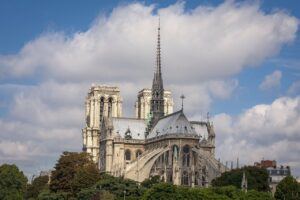A Union Ph.D Student Shares Thoughts on Notre Dame

PHOTO: Pixabay / CC0 Public Domain
On April 15, 2019, the world watched in shock and dismay as flames engulfed Notre Dame de Paris Cathedral, burning the building’s delicate and recognizable spire and most of its roof. Luckily, the interior avoided extensive damage thanks to its stone vaulted ceiling. Also, many works of art and religious relics were moved to safety. With rebuilding already underway, interest in the structure and its history has increased. Art historian and Ph.D. student Bruce Maggi shares some thoughts on Notre Dame the significance of the iconic structure.
Q & A with Bruce Maggi
Q: Can you give us a brief history of the cathedral?
A: Notre Dame de Paris is more than 800 years old. It sits on a small island called the Ile de la Cite in the middle of the River Seine in the heart of Paris. The cathedral was built over the course of 200 years; it was started in 1163 during the reign of King Louis VII and was completed in 1345. It was built on the ruins of two earlier churches, which were themselves predated by a Gallo-Roman temple dedicated to the Roman god, Jupiter.
Notre Dame was, at one time, in a stage of total disrepair and close to the point of being demolished, but was later saved by Napoleon who himself was crowned Emperor in 1804 inside the cathedral.
The cathedral was one of the earliest structures built with exterior flying buttresses. These buttresses allow for the tall walls and large amount of stained glass windows. The buttresses act basically as an exoskeleton that takes the weight of the room off the walls and directs it out of the main building.
Q: What attracts people to visit the cathedral?
A: Notre Dame de Paris is visited by approximately 14 million visitors per year, even more than the Eiffel Tower. Notre Dame has been visited since its completion. It falls as part of the Reliquary route that worshipers would use across Europe during the Middle Ages. The cathedral houses numerous relics that are very important to the Catholic Church, including the Crown of Thorns of Christ and piece of wood said to be from the cross on which Jesus was crucified.
Q: What should people know about the cathedral that they don’t know?
A: Numerous cathedrals and churches share the name Notre Dame. Notre Dame means “Our Lady,” for the Virgin Mary.
The cathedral contains one of the oldest surviving wood timber frames in Paris, involving around 52 acres of trees that were cut down in the 12th century. Each beam is made from an individual tree. For this reason, the lattice of historic woodwork that burned in the fire was nicknamed “the Forest.”
If you look at a photo of the cathedral from before the fire, you’ll see a rooster on top of the spire. This rooster was not a purely decorative bird. In 1935, three tiny relics—an alleged piece of the Crown of Thorns and some bits of Saint Denis and Saint Genevieve (the city’s patron saints) were secured inside the metal bird’s body. The idea, the story goes, was to create a sort of spiritual lightning rod to protect the parishioners within.
All 20 of the bells in the cathedral except for Emmanuel (weighing 13 tons) were melted down to make canons during the French Revolution.
About Bruce Maggi
Maggi is a Ph.D. student with a concentration in Humanities & Culture at Union Institute & University. He is also an art history professor at Horry-Georgetown Technical College in Conway, SC. Maggi earned a M.Ed. in 2006 and a M.A. in 2014, both from Union Institute & University.
PHOTO: Pixabay / CC0 Public Domain